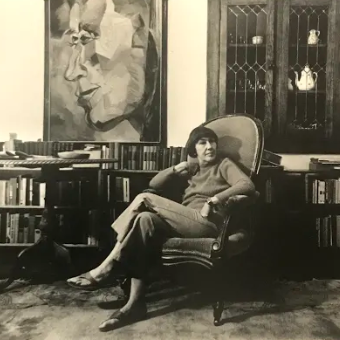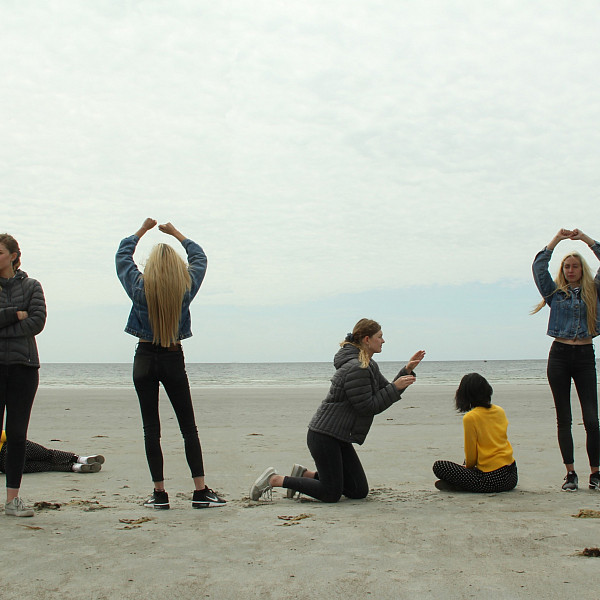News
Art History Mystery, Part 3
November 18, 2019
November 18, 2019
Open gallery

In the fall of 1941, Elizabeth Tracy Montminy’s mural, Bathers, adorned a wall in the Kennebunkport, Maine, post office, much to the chagrin of stodgy locals. By 1945, after months of savage criticism, the controversial artwork had been removed—and then promptly vanished into thin air. In summer 2019, Montminy’s former student, Southwestern Professor of Studio Art Victoria Star Varner, and three of Varner’s own mentees—Sophia Anthony ’19, Kati Hellmer ’19, and Danbi Heo ’19—journeyed across the country to locate the missing mural.
Today, a vibrant depiction of vacationers enjoying a summer day at Goose Rocks Beach stands proudly in the drawing studio of Southwestern’s Sarofim School of Fine Arts.
Note that I said a, not the, vibrant depiction.
Indeed, the whereabouts of Montminy’s original mural remain a mystery. Varner and her students did discover several revealing documents during their trip, and after finding one significant letter penned by the artist in Missouri, Anthony proclaimed, “I feel like I’m in documentary!” However, despite the valiant efforts of SU’s intrepid artist–detectives, the question of whether Bathers was destroyed or remains tucked away in some unidentified archive or private art collection goes unanswered for now. It’s an outcome that many researchers are familiar with: regardless of intense intellectual curiosity and days spent diligently scouring multiple archives, we do not always find what we are looking for.
Nevertheless, anticipating the possibility of such a disappointment, Varner had planned a new approach to recovering the scandal-clad painting even before their research trip began: she and her students would recreate the mural as faithfully as they could based on their findings at the three archives. “Making a painting can be a political act, and this instance is an important act of righting a historical wrong and amending the reputation of Elizabeth Tracy Montminy,” Varner says. And given the misogyny exhibited by the body-shaming critics of 1940s Kennebunkport, the SU professor was moved to engage feminist artists in the recreation. “The performance of it is a feminist act,” she adds, “and everything we do in this project is part of our collaborative work of art.”

After their return to Southwestern, Varner, Anthony, Hellmer, and Heo began to work on their recreation. They started with a sketch, outlining basic shapes before developing the details of what one 1940s critic once uncharitably referred to as “disgusting, corpulent bathing figures.” As if reclaiming Montminy’s work stroke by stroke, the artists added depth and shading to faces, muscular bodies, parasols, and even an inflatable inner tube. Whereas conservative Kennebunkport had objected to the portrayal of “scantily clad” beachgoers, contemporary photography reveals that Montminy was merely depicting the fashion of her time; viewers today would be especially hard-pressed to call any of the swimsuits risqué. Men, women, and children play in the sand, talk, or sunbathe against a cobalt sliver of sea and a sky transitioning from clear, bright, and blue to storm clouds above Montminy’s self-portrait as one of the bathers. Varner interprets that this last was her mentor’s suggestion of the tempest of controversy brewing as petitions were circulating to remove Montminy’s mural even as she was painting it.
Even in its inchoate state, the recreated mural is a triumphant rainbow of vivid color. And unlike Montminy, who once complained that she “spent several miserable months on a scaffold in the Post Office listening to scathing remarks,” Varner, Anthony, Hellmer, and Heo can celebrate having collaborated on their beautiful work in the comfort of the SU painting studio, without a malicious word to be heard.

Varner plans to exhibit the new interpretation of Bathers here at Southwestern in 2020, when it will be transferred to the Kennebunkport Historical Society as the centerpiece of an exhibit on the controversy. There, the children and grandchildren of those who once protested the piece can appreciate and admire this tribute to and remaking of a historical artwork that once graced their post office. The Boone County Historical Society in Missouri has also asked to exhibit it, and there is growing interest from other venues.
Beyond the recreated mural, the Montminy-inspired project will also spawn a number of possible related multimedia artworks; after all, as Varner comments with relish, “Well, as art goes, things sometimes take off in unexpected directions.” She’s contemplating producing a video featuring excerpts from the 1940s critiques. During their research travels, she also captured footage for a video of Anthony, Hellmer, and Heo “disporting themselves on a beach”—a callback to Senator Wallace H. White Jr.’s objection to The Bathers. “I’m not sure where all this will go,” Varner says, “but that’s part of the excitement of being an artist!”
Varner encourages others to report any information they find about the missing Montminy mural to her atvarnervs@southwestern.edu. This project is funded in part by a competitive faculty-development grant and friends of Sarofim School of Fine Arts.

















